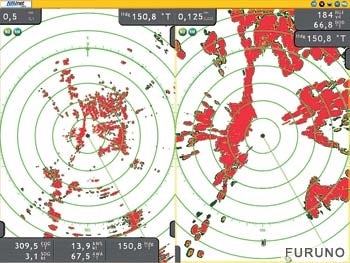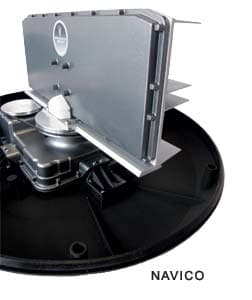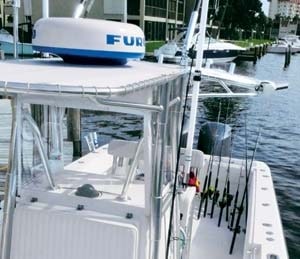
Once identified with big convertibles and high-tech tournament fishermen, radar is finding a place on a wider range of fishing boats, where it adds considerable safety to the electronics suite. Digital signal interpretation makes the image and the interpretation more intuitive. Advances in automatic gain and noise control eliminate the mystery and guesswork that formerly demanded hours – or years – of experience to decipher.
Furuno added unprecedented capability to radar last year with the introduction of the radar component of the then-nascent NavNet 3D system.
Tagged “Ultra High Definition Radar,” the new scanners represented a ground-up redesign, with advanced signal processing and the capability to generate two separate signals, creating a real-time dual-range radar. When you split the MFD screen for two radar displays at different ranges, each signal is autonomous, allowing for manipulation of individual range, gain and clutter controls.
Leading the line for fishing boats are the 19-inch 2.2 kW DRS2D ($2,400) and the 4 kW 24-inch DRS4D ($2,600), radomes that incorporate both the advance processing and streamlined integration with the NavNet system.
“Our sensors are brand new, and everything is built in. The dual-range radar is phenomenal,” says senior product manager Eric Kunz. “With digital processing we can stream two independent video channels from the antenna. You can display one range at 18-mile range and the other at 96 miles – at the same time.”
Raymarine’s new Digital RD418D ($1,299 ) and RD424D ($2,039) feature 4 kW transmitters and low-noise receivers for better target detection, and they network seamlessly with Raymarine SeaTalk-compatible E-Series, G-Series and new C-Series Widescreen multifunction displays. They incorporate a combination digital/analog processor that provides top performance previously available only with an open array antenna.
“We did not have a radome solution for our G-series technology until now,” says Raymarine’s training manager, Jim McGowan.

The new antennas are sized for boats in the 33-foot range and are compact enough to fit on a T-top or half tower, yet they offer top-of-the-line performance.
“With Super HD digital signal processing we can mimic a larger antenna and give a 4 kW transmitter the performance of the 8 or 12 kW transmitter with a larger antenna, gaining resolution and better target discrimination,” says McGowan.
Installation is also simplified on the new domes, with lighter Ethernet cable between the scanner and the network, which still allows for display on multiple MFDs.
Navico has taken a big leap in radar technology with the release of Broadband Radar, which has debuted in the Lowrance HDS series; Simrad GB 40 NX series of 12- and 8-inch MFDs; and Northstar 8000i and M-series. Prices have not yet been announced.
Broadband is more a marketing term than a technical description, but the technology itself is completely new for recreational fishing boats. Navico has eliminated the traditional signal transmitter, the magnetron, and replaced it with a solid-state transmitter and receiver. The solid-state components deliver a continuous low-powered transmission as opposed to the high-powered pulse of traditional magnetron radars.
“Rather than a short 2,000- or 4,000-watt pulse, we are transmitting a .1-watt signal continuously,” explained Greg Konig, vice president of product management for Lowrance.
The result, he says, is improved target discrimination, natural clutter suppression, lower power requirements and instant start-up.
“With traditional radar,” he says, “there is a delay between when the signal is sent and when the receiver can actually hear it coming back, and that delay causes blind spots around the boat and creates a lot of noise.”
The continuous signal of Broadband Radar boosts target discrimination, whether it’s 10 yards or 10 miles away. “You can see separate targets better, and that ability translates to objects near the shore,” he says. This separation is valuable in identifying another boat up against mountainous background, or when running past a large ship. It provides safety and performance benefits in terms of situational awareness for collision avoidance.”

The low power requirements provide two benefits: greater safety due to decreased radiation output, and less power draw on the boat’s electrical system.
“Broadband has 50-percent better power efficiency than a 4 kW radome, a nice benefit for smaller boats looking for a system that’s easier on their batteries,” says Konig.
The instant-on capability also allows anglers to use the radar differently than is possible with traditional systems.
“Put it in standby, and it runs at 1.7 amps,” says Konig. “Then you can go to ON instantly. It is useful for keeping an eye on things around you. You pop it on a for a few minutes then shut it down again.”
So what is the downside?
“The range is limited to 24 miles,” says Konig. “There are still benefits to more powerful radars that we are not claiming. This will not replace an open array radar for watching weather 100 miles away or birds 10 miles away. But we’re not trying to do that.”
It’s a trade-off Navico is willing to make, he explains. With the advent of satellite weather services such as Sirius, there’s sophisticated real-time weather radar available to anglers with the addition of that service. The weather-reading capabilities of a marine radar for most fishermen become moot.
Konig believes Broadband Radar delivers the benefits of the technology to an eager market of small-boat anglers.
“There are a lot of boaters who over the past 10 years have become educated to radar, and they tend to own small center console or walkaround boats, but they are going offshore in them,” he says. “People realize that radar is an important safety device. The advantage of Broadband Radar is it’s available to smaller boats, with the benefits of low power consumption and emissions and ease of use.”









